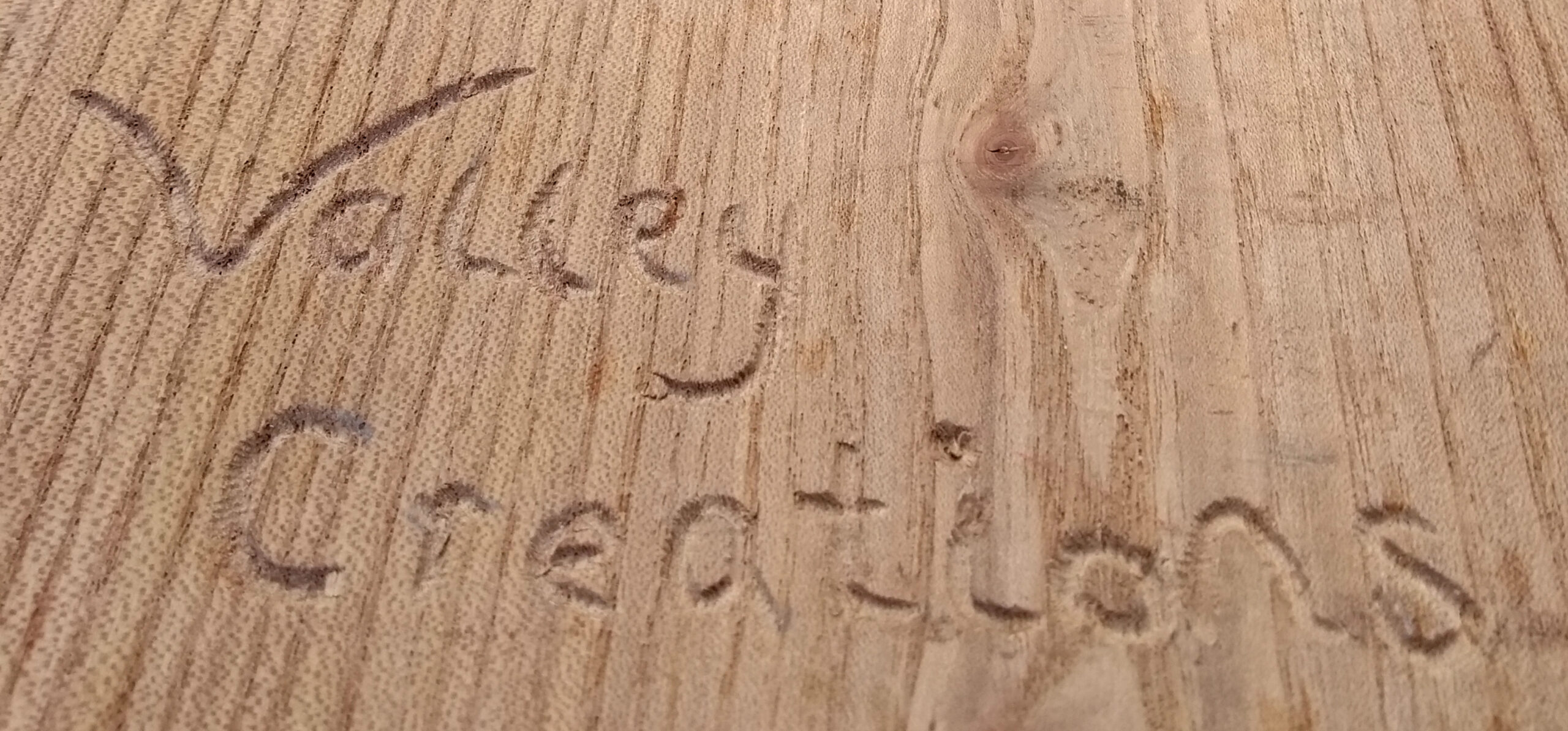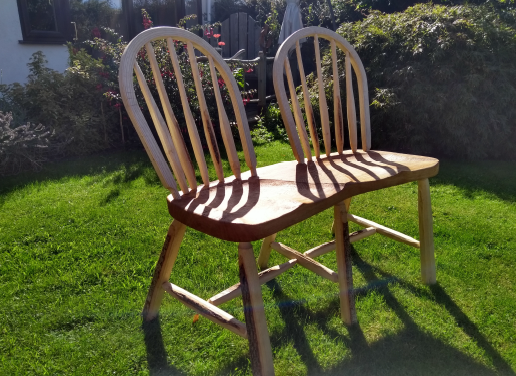The Basic Geometry of Chairs
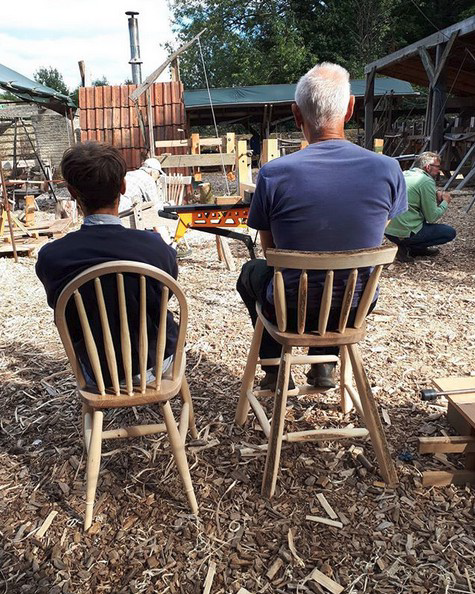
If you follow ready made chair patterns and use common leg and back angles, you may not have to think too much about the structure. If you want to check what you are doing or design your own chairs, then it is very helpful to have some understanding of the principles and forces involved. After listening to a surgeon explain his technique using a reamer to drill the mortice in my femur, I got to thinking about how many mortice and tenon joints there are in a chair. One of my rocking chairs might have thirty and I have one I bought years ago that has sixty. Understanding the principles can help a lot.
Let’s keep it simple and ignore some of the variety of chair design options available. Whatever name they use for it (the base, the undercarriage, the legs) most Windsor chair makers tend to view the chair as a stool with a back on. The leg structure is tenoned into the seat from below to make the stool and the back structure is tenoned into the seat from above, usually after the stool is made. Excusing the geometry jargon, both the stool and the back use either triangles or trapezoids to give strength. If you look at the trapezoid below you can see the common shape of pairs of legs, whether front to back or side to side. This shape is more stable than a square, as collapsing one part of it requires lift in another part and thus gives resistance to the collapsing force.
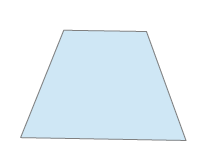
In most Windsor chair stools the full trapezoid is created by the stretchers between the legs. If you look at the chair on the title page you will see that the side stretchers create a direct trapezoid with the legs and the seat. The trapezoid for the front and back pairs of legs is created indirectly via the side stretchers by the cross stretchers.
If you now look at the chair at the rocking chair from the side again with that structural eye you will see that there is some excess structure there. The rockers actually create the trapezoid, so the side stretchers are redundant, if you put the cross stretchers directly between the front and back leg pairs. Actually good tenons into the seat and the right woods can make such a stable structure that the stretchers can be viewed as over engineering. In theory the trapezoid is created by the friction of the legs on the floor. That stability depends on the angles the legs enter the seat, the floor surface, the quality of the woodwork and woods and the weight and stability of the person sitting on the chair. Most people choose to build some contingency strength in. The decisions you make are all weighing up your own level of skill, the materials, your control over the possible uses the chair might be put to and then aesthetics and weight. The chair at the front is designed to sit on a semi protected shed porch, as close to the shed side as possible and to serve both as a rocker and as a dining chair, so it is a set of compromises. For instance if it had a stretcher across the front, then it would not be possible to tuck your legs under when you sit forward to eat.
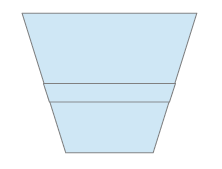
Let’s look at our trapezoid again but the other way up. Imagine this shape for the legs and seat. It is still a trapeze with its built in stability advantage. Here though, the pressures downwards from someone sitting on the seat actually work to pull apart the tenon joints with the stretchers. Is that all that is wrong with it? Apart from anything else it just looks wrong, but it also means the the chair is more likely to fall over if rocked. Rocking either way in this trapezoid immediately drops one end of the seat and though it raises the other, it also drops the centre of gravity very quickly. When legs point out, any rocking force has to raise the seat at both sides to get it to the point where it can fall over and this works against the downwards forces created by the person sitting on the seat, indeed by the weight of the seat itself. The centre of gravity actually rises at first. We could splay the legs out wider and this effect would be increased, but it would also increase the effect of the downward forces from just sitting on the chair. All the decisions you make are compromises of some sort or another.
Below is the completed bar stool design I am sitting on in the earlier picture.
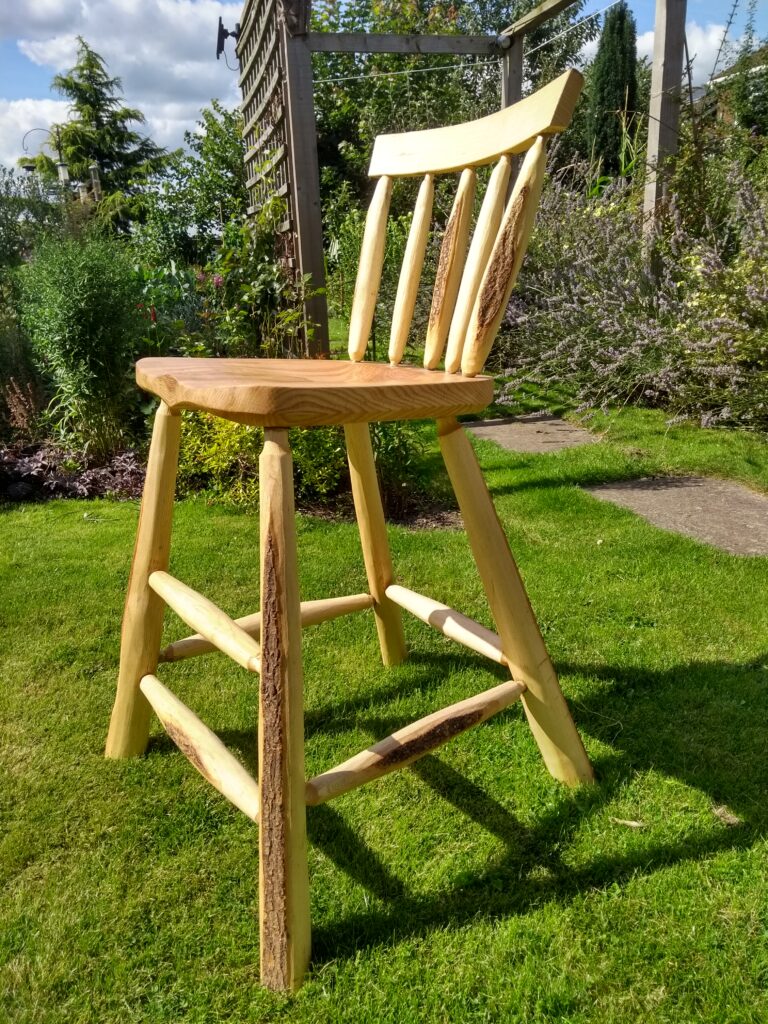
The intended function of the chair also has an effect on the decisions that are made about the angles of the sides of the trapezoid. Dining chair legs traditionally have more upright legs. One reason for this is that you tend to be trying to fit as many round a table as possible and not have people trip over the legs as they squeeze in, so a wide leg base is a nuisance. Another reason is structural. Because the seat tends to be slightly higher than a relaxing chair, this make the legs longer and thus the leverage forces are increased and a more upright leg reduces this. A rocking chair is the opposite of this. The rockers complete the trapezoid shape at the bottom of the legs, making it strong. If you have the traditional side and cross stretcher arrangement, you can splay the back legs out further because there is more working against the forces trying to make the seat collapse downwards. In addition the rocking of the chair moves the centre of gravity back and forth and the leg angles effectively alter accordingly. It is also worth remembering with a rocker that the other end of the rocker effectively pushes up as you push down so the forces are spread through the whole structure in a positive way. I will go into this in more detail later.
How about the shapes in the back of the chair? Below is my New Zealand chair in production on which I have highlighted another trapezoid for you.
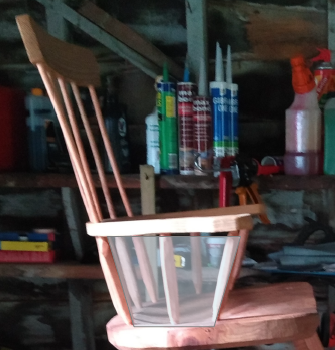
This one is the other way up to the normal leg pattern. In this position it has to deal with a different range of pressures but also has to take function into account more directly. To cope with downward pressure it would be better the same way up as the legs but that would narrow from your bottom to your waist and require you to slide yourself in from the front, like assemblig a dovetail joint. This structure has to deal with the pressures created from leaning on the back are these are increased by its length. They are partly countered by the downward pressure on the arms but also by the greater angle of the front sticks. If you put one of these together without glue, you will find that backward pressure on the back creates an upward pressure on the front of the arms and that in turn will lift the stick out. The greater angle counters that pressure and in other uses the forces downward on the trapezoid from you arms are slight compared to the pressures the stool receives. In addition you can move the hole in the arm for the forward support stick very slightly forward and this creates a small tension that holds the structure together mechanically. The more upright of the two arm sticks can then act in compression to counter the downward forces on the more highly angled front arm stick.
If you look at a trapezoid, it is actually a square with two triangles attached and the triangle is another structurally strong shape. In a traditional bow or comb back (see below), the stiles or bow ends are placed forward of the centre stick. This creates a triangle often envisaged like the picture on the left below, but actually transferring forces more like the picture on the right.
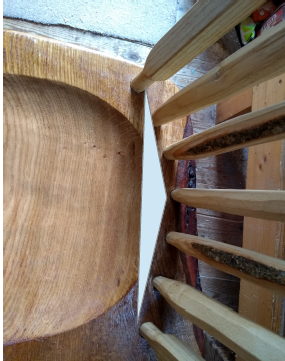
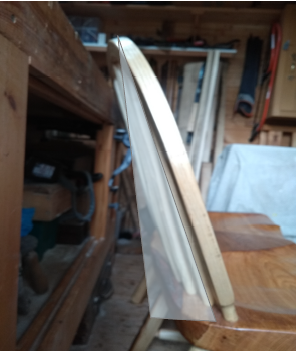
On some chairs you will see an additional stick behind the back coming from the top of the back down to an extension backwards of the seat, which is another triangle designed to spread forces and thus support loads.
Before we leave triangles it is worth mentioning another, that chair makers think about when making a rocking chair, the one made by the rockers and the top of the back of the chair, especially if children are likely to stand on the seat and start rocking. From the picture of a child’s rocking chair below you can see the triangle.
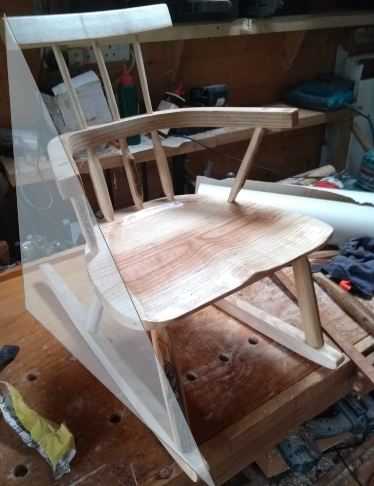
The final shape that is worth thinking about is the one made by the points where the legs stand on the floor. This is often roughly square like the one in the picture below.
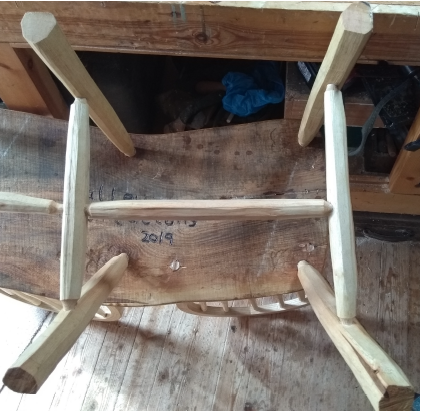
In a chair with a fairly common seat shape, that is slightly narrower at the back than at the front, achieving a square involves splaying the legs out further at the back. You can check the shape made by the legs by putting the seat upright and level in a vice then putting a pair of legs in the mortices and checking with a level. If you are making a tapered mortice, you can do this as you work the taper and adjust accordingly. You can adjust an ordinary mortice slightly in the same way. The square shape made by the four leg bottoms is not that important structurally, except it does reduce the tendency to tip over slightly, so some designers keep the same leg angles front and back and then the pattern of the legs becomes a trapezoid, with the back legs slightly in from the line of the front legs. There is a general view that the back legs should not be wider than the front legs and that the whole should be symmetrical, but, as the picture above shows, all rules are there to be broken if they do not affect the structural integrity. On this curved two seater bench the shapes mean that the slightly wider back legs and asymmetrical middle back middle leg work well in a number of ways.
I find that keeping these shapes in mind allows me to picture the effects of design decisions on the forces involved. As highlighted in the case of the arm sticks, once you understand those forces, you can also make very slight adjustments to the positions and angles of mortices that add other gentle forces to help the chair stay together. If you are worried about your design or making skills or the strength of the wood then add more structural elements or change angles slightly so they add extra stability. As you get more confident and understand it all better, it is possible reduce the size and number of all the structural components and it can become a challenge to go as light as possible while maintaining practical strength. Going back to the bar stool above, it would be possible to reduce the leg significantly and still maintain structural integrity, resulting in a chair with a different visual appeal. One final word on these shapes and the physical act of putting together (framing) the chair. The trapeze that makes up the legs means that the holes that are drilled into the seat are at an inward pointing angle. In practical terms this means that when you put the ends of the four legs in the holes and knock them in, the ends become closer together, squeezing the legs together and squashing the stretchers. On my first rocking chair this squeezing effect, together with the controlling effect of the rocker tenons, made the mechanical fit so strong that I have not bothered to put any glue in the joints and it is still happily rocking away several years later. I will come back to some specifics of this later.
